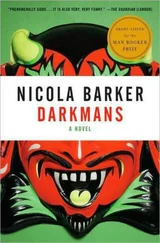I believe I may already have hinted earlier that Uncle had become much more strict in his adherence to the rules of caste since his boyhood misadventures. Uncle was now nineteen. His family was still very concerned for his mental well-being. Uncle had a profound contempt for all worldly things—“for woman and for gold.” The love of God was his only interest. And when Ramkumar gave his advice to the Rani, Uncle was not entirely happy with it. Uncle was a wet blanket. Uncle was very concerned at the idea of a Sudra serving cooked food — even under his brother’s strict provisos. My, how things had changed! Now Ramkumar was playing fast and loose with the laws of caste and Uncle was trying and failing to make him conform to a more conservative way of thinking.
Surely God works in mysterious ways! Perhaps we are all destined to make our own mistakes and then to suffer the indignity of living through them again and again in the mistakes of those closest to us?
So Ramkumar installed the beautiful black basalt image of Kali in the Dakshineswar Temple and then stayed on as priest. There was much celebration and feasting. Considerable amounts of money were spent, Uncle says, and many precious gifts handed out to pandits and pilgrims. Ramkumar — true to his word — accepted the cooked prasad from the temple. But when Uncle attended the grand festivities he refused to eat the food, preferring to receive uncooked provisions from the temple store and then make his own private dining arrangements. Uncle is stubborn. And as soon as the deity was installed he returned to Calcutta, by foot, fully expecting that his brother would follow on shortly after.
But Uncle was wrong. He waited and waited for Ramkumar’s return, yet Ramkumar never came. Another priest could not be found to officiate at the Kali shrine and so the Rani respectfully asked Ramkumar to stay on. Which he did. Ramkumar believed that the Dakshineswar Kali Temple was a good environment for Uncle, a place where he might prosper, find new opportunities, and move forward with his life.
It would take some considerable amount of time before pilgrims and visitors felt ready to accept the cooked food at the Dakshineswar Kali Temple, Uncle says. People are naturally suspicious and also stuck in their ways. The Rani had thrown money at the problem, but life teaches us that money will not buy you everything. Uncle suspected that it may have bought the Rani the services of his brother, and this thought made him very unhappy. But after a few weeks of living on his own he was obliged to cave in and move to the Kali Temple to be with Ramkumar. His brother was much older and Uncle loved him very dearly — almost like a father — although God teaches us that all human attachments will ultimately end in tragedy. They are impermanent. They are a part of the bewitching illusion of maya . They are fleeting and unreal. Because only the love of God, as Uncle never tires of telling us, is completely real, after all.
If you were a little Indian swift ( Cypselus affinis ) dashing around catching insects in the newly opened Dakshineswar Kali Temple grounds circa 1855, what great delights might you espy with your tiny, beady, and perpetually darting swifty eye?
Well, let’s get one thing straight right off the bat: cute and charming as this idea undoubtedly is, an Indian swift is not remotely interested in aesthetics or in architecture. All objects — no matter how grand or ornate — are merely objects to a swift, just abstract shapes, and are of interest only insofar as he/she can avoid them, eat them, shit on them, or construct a nest upon them. Swifts — unlike swallows — do not tend to perch. The Indian swift has funny little feet that aren’t shaped as other birds’ are. The claws are powerful (designed for hanging on to things), but the individual toes are splayed out, not unlike a gecko’s, and this makes it more tricky for them to both hop around and stand about. They live on the wing. In fact, the only time an Indian swift stops (either its shrill screaming or its acrobatic flying) is when it enters its nest (which is made of mud, feathers, and copious quantities of sticky swift spit).
Perhaps rather than relying on the little swift’s eye and limited brain capacity (not to mention its fractured swift thoughts of “ Safe … DANGER … left, right, SWOOP, avoid, quick, BIG, empty, light, dark, hungry, mosquito …” et cetera) we should attach a tiny camera to our circa-1855 Indian swift’s compact torso and proceed gingerly on that basis. Let’s catch one. Go and fetch your butterfly net. This shouldn’t be too difficult because the circa-1855 Indian swift is quite silly and highly accident-prone.…
Excellent! In the blink of an eye the job is done. A miraculously tough but tiny and portable technology is deftly applied, suspended (on a modern twine as flexible, light, and strong as a spider’s silk) so as to hang at the bird’s throat, just under its beak. You will observe that we have even coordinated it with the circa-1855 Indian swift’s greenish-black plumage, and if you look especially closely (with the aid of a magnifying glass, perhaps) you will see our tiny Cauliflower™ logo exquisitely painted just below the camera’s lens, which — in its entirety — is only the size of a large pinhead. The whole piece of kit is, in fact, lighter in weight and smaller in diameter than a midsized, blood-bloated tick.
Right. Let’s toss him up into the air and see what he can find out for us … whoosh! Fly, little swift, fly!
Ah, he’s momentarily spooked and so is heading straight for the holy Ganga. Technically speaking this is actually the river Hooghly, which is a large, tidal tributary of the Ganga but is considered equivalently holy and sacred (because it originates at the same source and contains the same water). You will observe two (count them!) bathing ghat s. A ghat is a series of twelve shallow steps (both of these are constructed from a lovely red brick) leading down directly into the river so that pilgrims and visitors can remove their clothing and bathe in the holy Ganga water (an act which is believed to purify the soul and wash away one’s sins).
Oh dear. Are the high-pitched screams of the circa-1855 swift bothering you at all? Perhaps I might … yes … just turn the volume down a little … uh … good … that’s better.
At the top of the main ghat is a large, open portico or chandni , a place where the many bathers can find shade, undress, get dried, oil their bodies, and chat. You will see … whoosh … (as the swift quickly jinks under the chandni ) that some women bathers leave their sari s to dry in the warm, large, tiled courtyard which lies beyond, creating a dizzying patchwork quilt of explosive color. The tiles in this grand central courtyard area often get so hot that barefooted pilgrims are liable to singe their soles on them, and the temple authorities spread out grass mats to prevent … uh …
If we could just …
The swift has doubled back on itself in pursuit of a midge … but this is good. Yes. It allows us to see that on either side of the chandni , facing the water, is a grand line of twelve individual white, ornate, double-red-dome-roofed Shiva temples (six either side). Each of these contains its own natural stone lingam . Shiva, Lord of Destruction (although it should always be borne in mind that destruction is an essential/inherent part of the creative process, too), is traditionally depicted and worshipped by Hindus in an abstract form. Possibly these objects (these lingam s) are held to represent a phallus or a pillar or a sacrificial post. Whatever their origin, they are generally worshipped with simple offerings of bael leaves and milk.
Читать дальше












